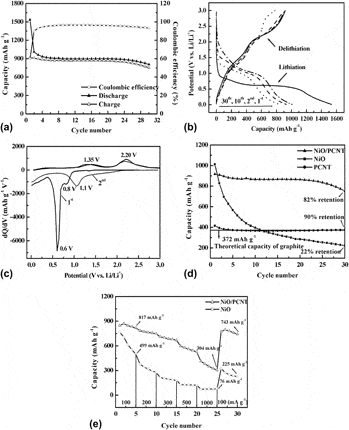Crossref Citations
This article has been cited by the following publications. This list is generated based on data provided by
Crossref.
Wang, Xiujuan
Wang, Gang
Zhai, Gaohong
and
Wang, Hui
2014.
Preparation and electrochemical evaluation of NiO nanoplatelet-based materials for lithium storage.
Journal of Materials Research,
Vol. 29,
Issue. 13,
p.
1393.
Zhou, Gang
Ma, Jianmin
and
Chen, Libao
2014.
Selective Carbon Coating Techniques for Improving Electrochemical Properties of NiO Nanosheets.
Electrochimica Acta,
Vol. 133,
Issue. ,
p.
93.
Fan, Zhaoyang
Liang, Jin
Yu, Wei
Ding, Shujiang
Cheng, Shaodong
Yang, Guang
Wang, Yonglong
Xi, Yingxin
Xi, Kai
and
Kumar, R. Vasant
2015.
Ultrathin NiO nanosheets anchored on a highly ordered nanostructured carbon as an enhanced anode material for lithium ion batteries.
Nano Energy,
Vol. 16,
Issue. ,
p.
152.
Wang, Xiujuan
Wang, Gang
Zhai, Gaohong
and
Wang, Hui
2015.
Nickel Oxide Nanoparticle-Assembled Microspheres with a High Rate Capability for Lithium Storage.
Australian Journal of Chemistry,
Vol. 68,
Issue. 6,
p.
964.
Zhou, Han
Zhang, Lusi
Zhang, Dongyang
Chen, Shuangqiang
Coxon, Paul R.
He, Xiong
Coto, Mike
Kim, Hyun-Kyung
Xi, Kai
and
Ding, Shujiang
2016.
A universal synthetic route to carbon nanotube/transition metal oxide nano-composites for lithium ion batteries and electrochemical capacitors.
Scientific Reports,
Vol. 6,
Issue. 1,
Zhang, Liugen
Li, Hui
Xie, Hongtao
Chen, Tingxiang
Yang, Chao
and
Wang, Jide
2018.
MOF-driven ultra-small hollow Co9S8 nanoparticles embedded in porous carbon for lithium-ion batteries.
Journal of Materials Research,
Vol. 33,
Issue. 10,
p.
1496.
Siddiqui, Safina-E-Tahura
Rahman, Md. Arafat
Kim, Jin-Hyuk
Sharif, Sazzad Bin
and
Paul, Sourav
2022.
A Review on Recent Advancements of Ni-NiO Nanocomposite as an Anode for High-Performance Lithium-Ion Battery.
Nanomaterials,
Vol. 12,
Issue. 17,
p.
2930.
Leonova, A. M.
Leonova, N. M.
and
Suzdaltsev, A. V.
2025.
Electrochemical Performance of NiO/C Anode in Li-Ion Power Sources.
Arabian Journal for Science and Engineering,
